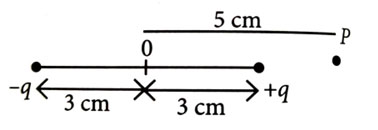Topic Question Set
Q 1
:
An electric dipole is placed as shown in the figure. The electric potential (in V) at point due to the dipole is [2023]


(3)
Here, the dipole distance is nearly equal to the distance between the point thus, we cannot apply the dipole formula directly. We have to calculate the potential. Hence, electric potential due to charge is given by,
due to individual charges
Potential due to charge at point is
...(i)
Potential due to charge at point is,
...(ii)
From equations (i) and (ii), we get
Q 2
:
Two point charges and are placed at a distance of , as shown in the figure. The magnitude of electric field intensity at a distance varies as [2022]


(2)
Since, the given charge configuration can be treated as dipole.
Electric field due to a dipole at any arbitrary point is
Here,
Q 3
:
Polar molecular are the molecules [2021]
having a permanent electric dipole moment.
having zero dipole moment.
acquire a dipole moment only in the presence of electric field due to displacement of charges.
acquire a dipole moment only when magnetic field is absent.
(1)
The polar molecules are the molecules have one end slightly positive and other end is slightly negatively charged separated by some distance.
So, they have permanent electric dipole moment.

